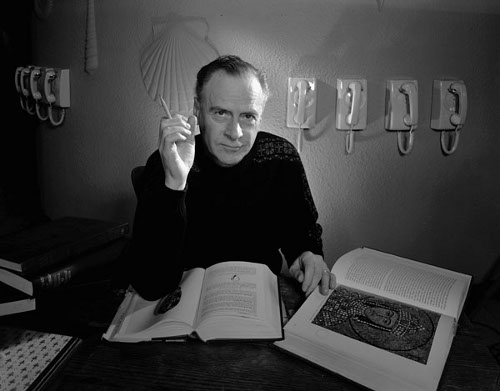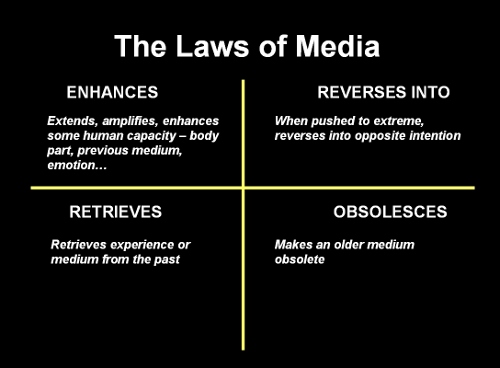Marshall McLuhan is gone, but his spirit’s livin on and on (Thanks Bob Dylan and Lenny Bruce). A course on media and communication at some point needs to engage with the contribution of Marshall McLuhan (1911-1980) to media studies. McLuhan is known for his phrase, “The Medium is the Message”, helping us think about the impact of a medium, beyond the content we usually focus on.
McLuhan was a professor of English literature, a literary critic, a rhetorician, and a communications theorist. He spent most of his working life at the University of Toronto, who worked with him to set up the Centre for Culture and Technology. See the Amazon.com widget at the bottom of the post for a selection of his books.

I find McLuhan’s book, Understanding Media, helpful in that it introduces a wide range of media that we often overlook. Here’s a list I used in the Media and Communication course last week to get us started.
- The Spoken Word
- The Written Word
- Roads & Paper Routes
- Numbers
- Clothing
- Housing
- Money
- Clocks
- The Print
- Comics
- Printed Word (Typography)
- Wheel
- Bicycle
- Airplane
- Photograph
- The Press
- Motorcar
- Ads
- Games
- Telegraph
- Typewriter
- Telephone
- Phonograph
- Movies
- Radio
- Television
- Weapons
- Automation
Laws of Media
We explored the laws of media, looking at the Massage effect, in which the introduction of new media shapes a society and connects with already existing media. “We shape our tools and thereafter our tools shape us”.
A new medium ENHANCES existing media, extending, amplifying, enhancing some human capacity. A new medium RETRIEVES experience or media from the past. A new medium, when pushed to extreme, REVERSES so that it’s effect is opposite to its original intention. A new medium OBSOLESCES, makes some older media obsolete.

We explored how these might apply to the latest mobile phones available on the market. The new mobile phone enhances the telephone by making it usable almost anywhere, with the addition of imagery and video footage. The phone can be used for internet access, GPS navigation, the playing of music and games, listening to radio. It retrieves the short text messaging capacity introduced earlier with the telegram. It has the potential to make many other media obsolete or dispensable, including land lines, purpose built portable radios and MP3 players. If use of the mobile phone is taken to extreme we can end up losing freedom rather than gaining it. Our lives can become driven by the need to access and share information and connect with others.
So what message does the mobile phone carry within itself? Our value of compact, multi-functional and mobile devices is a reflection of our ever increasing individualism. However our concern about being connected at all times and in all places says something about our hunger for community. We are tempted by the offer of disembodied communication, in which we can avoid face to face, body to body meetings with our peers.
The data projector ties together the functions of film projector (with spools), overhead projector (with transparencies), slide projector, television screen and computer screen. Connecting the projector to other media input (computer, DVD or video, or advanced mobile phone), along with HiFi sound reproduction, makes it possible to achieve a high quality audio visual experience without the worries associated with moving parts. The data projector has already effectively replaced slide, film and overhead projectors, and has the capacity to make obsolete the distribution of printed paper in public gatherings. If used without care, the data projector has the capacity to remove our capacity to read and reflect before and after shared experiences. Live communicators can find themselves outpaced by their own tools unless they continue to hone their capacity for engaging in an interactive manner.
The message carried within the medium of data projector is tied up in search for audio and visual entertainment. What’s missing? Taste, smell, touch and interactivity. We’re presented with a screen from which emanates our cues for thinking and feeling. Without dialogue and response we run the risk of becoming receivers alone rather than responders.
Here’s a clip from the 2002 documentary ‘McLuhan’s Wake’ released by the National Film Board of Canada, available in the Amazon.com list below. The video includes a visualization of Edgar Allan Poe’s story, The Descent into the Maelstrom, in which a sailor manages to escape a whirlpool only by studying the effect of the vortex on the objects swirling around him.
Click on the image below to play the video in YouTube (HD)
https://www.youtube.com/watch?v=duplpYN5nmE
Links
Marshall McLuhan Official Site
The Marshall McLuhan Program on Culture and Technology
Marshall McLuhan on Wikipedia
